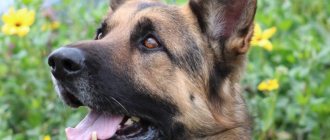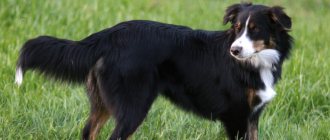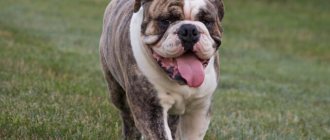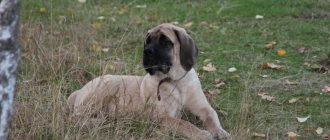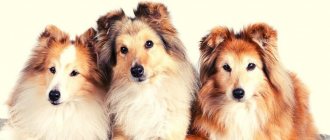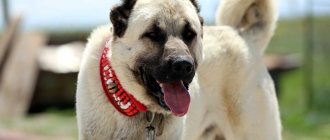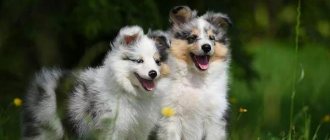The German Shepherd is one of the most famous working breeds in the world.
It is considered a universal working breed and can perform various duties.
German Shepherds are used to work in the army, police, rescue services, and also as guards and companions.
They are also known for their sporting achievements.
It is impossible to remain indifferent to these strong and beautiful dogs, which is why they have so many fans all over the world.
Brief description of the breed
The German Shepherd is a dog of medium height with a slightly elongated format and well-developed muscles .
At first glance, she gives the impression of an intelligent, alert and strong animal. The characteristic shape of the head, muzzle and erect ears, slightly rounded at the ends, make the shepherd look like a wolf.
Intellect, nobility and selfless devotion to the owner shine in the dark brown eyes.
The German Shepherd should give the impression of harmony, self-confidence and natural nobility.
Read more about what a German Shepherd looks like here.
Origin story
Herding dogs similar to the German Shepherd have long lived in the territory of modern Germany.
These were strong and brave animals, protecting not only livestock, but also farmsteads from the invasion of robbers and not afraid to engage in single combat with wolves.
By the beginning of targeted breeding work in Germany, there were many excellent working shepherd dogs, which became the founders of the new breed.
This happened at the end of the 19th century and very quickly the physical characteristics and working qualities of the German Shepherd made them popular. Around this time, their use in the army and police service began.
The creator of the German Shepherd and the first of its breeders is considered to be German cavalry colonel Max von Stefanitz . He bred these dogs from 1884 to 1896 and did a lot for the recognition and establishment of a new breed.
Price
If you dream of becoming the owner of one of the most popular dogs in the world, we recommend going to a kennel for her. No, you don’t have to go to Germany; there are high-bred “Germans” in almost every country in the world, including Russia. The price of a German Shepherd from a kennel is from 15 to 25 thousand rubles. It depends on the age of the puppy, as well as on its compliance with the standard.
The cost from private breeders is lower (from 6 to 12 thousand rubles). If you do not need full compliance with the dog’s breed standard and its pedigree, we recommend saving money and using their services. However, before purchasing, be sure to inquire about the vaccinations that the puppy received.
Character traits
Distrustful of strangers, brave and loyal animals with protective instincts inherent in them by nature.
The German Shepherd has a balanced character , does not show aggression without reason and can attack only on the orders of the owner or handler .
Impeccably obedient, incorruptible and decisive, this dog is distinguished by intelligence and intelligence.
The German Shepherd perfectly understands the difference between work and everyday life..
Expert opinion
Kozhevin Semyon Kirillovich
Expert dog handler.
“The German Shepherd is considered a versatile breed. Being incredibly smart and quick-witted, she learns easily and remembers commands well. Loyal, devoted and obedient, these dogs try to please their owners and live for work. And, thanks to their endurance and unpretentiousness, they easily adapt to almost any climatic conditions."
Is it possible to keep it in an apartment?
It is possible to keep a German Shepherd in an apartment and it will not cause any difficulties, but only if several conditions are met.:
- when choosing a place, it is necessary to take into account the size of an adult pet - the dog should be comfortable, it should be able to stretch out to its full height during sleep and rest;
- a bed, mattress or bedding should also be selected in accordance with the size of the animal;
- The place should be chosen so that the pet can see the entire room and doors from it - this need is due to the watchdog instincts of the German Shepherd.
However, the most important condition is regular walking of the pet, the ability to provide it with constant physical and mental stress..
Otherwise, the dog will be bored and will find an outlet for accumulated energy through damage to property and other unpleasant moments for the owners.
Advantages and disadvantages
pros:
- Smart, quick-witted and easy to train.
- Exceptionally loyal.
- Unpretentious in care and maintenance.
- Loyal to children.
- He understands perfectly well when manifestations of aggression are appropriate and when they are not.
- An excellent guard dog.
- Universal breed.
Minuses:
- Needs serious training.
- Cannot do without heavy physical activity.
- Not suitable for the role of a lap dog.
- If improperly raised, it can show aggression.
- Some Shepherds can be hyperactive.
German Shepherd is prone to nervous breakdowns due to overtraining.
Weimaraner
- Height – up to 70 cm
- Weight – up to 40 kg
A gun breed, previously used for hunting and guarding. The coat can be long or short, the color is silver-gray. The Weimaraner is distinguished by its attentiveness, devotion, love for children and activity.
Pros:
- loves to learn new things and quickly remembers new commands.
Minuses:
- It’s hard to get along in an apartment.
Main types
Currently, there are several breeding lines of German Shepherds.
The most popular is the classic, also called high, German line. These dogs are distinguished by their loyalty and love for people, which is why they are often used as guides for the blind.
Working lines of the German Shepherd are highly trained and are used in military service and for police work .
The Eastern line was bred from dogs with excellent physique and calm disposition.
Shepherd dogs of Czech working lines are distinguished by their endurance and are able to withstand serious physical exertion for a long time.
The American Shepherd line, bred in the 1970s, has an angular build, a longer muzzle and a relatively gentle temperament.
English Shepherds seem powerful due to their strong bones and elongated format . These dogs were bred for military purposes.
Among the long-haired German Shepherds, two varieties stand out: the Royal and the Sarlouz Wulfhound. The latter were bred in the Netherlands and carry an admixture of wolf blood.
There is no such thing as a dwarf German shepherd . Short dogs appear due to a genetic mutation, which is why they may have many congenital pathologies.
Color variations
Acceptable colors of German Shepherds :
- black;
- black-and-white;
- zonal (zonal gray and zonal red).
In this case, the first two are considered the most preferable.
There are also white shepherd dogs, separated into a separate breed - the Swiss Shepherd.
Nutritional Features
The German Shepherd can eat natural food or commercial food.
IMPORTANT!
Natural food should be fresh, good quality and balanced.
The finished food must correspond to the age and physical condition of the shepherd and be of high quality.
The diet of an adult shepherd and the nutrition of a puppy have their own specifics for this breed.
Health and major diseases, life expectancy
The German Shepherd is considered a healthy breed.
But she may also have a predisposition to the following diseases:
- Diseases of the digestive system.
- Otitis.
- Dysplasia.
- Allergy.
- Dermatitis.
- Hind leg failure.
average lifespan .
Dogs of this breed need to be vaccinated on time, as they are particularly sensitive to serious infections.
Interesting Facts
Germans are rightfully considered the No. 1 breed in the world. The following interesting facts are associated with these brave animals:
- Working German Shepherds have saved many people. In doing so, they often sacrifice their lives.
- Representatives of the breed reach maximum speed almost instantly. They do not lose their balance during sharp turns and never stumble.
- During the war, dogs worked as sappers, orderlies, messengers, and carried cartridges.
- The clamping force of the jaws during a bite exceeds 100 kg/cm².
- A powerful animal with a muscular body and dry bones is capable of speeds of up to 50 km/h.
- Several monuments have been erected to the Germans. One of them is located in Tolyatti - here a dog waited for its owners on the side of the road for 7 years.
Weight and height standards
The size of the German Shepherd allows it to be classified as a large breed. This category includes animals whose weight exceeds 25 kg and height reaches 60 cm.
The breed standard establishes the following physical parameters:
- height at withers for boys 60–65 cm, for girls 55–60 cm;
- average weight 30–40 kg and 22–32 kg, respectively.
Important. The German Shepherd standard excludes animals higher or lower than the specified parameters by more than 1 cm.
The breed has pronounced sexual dimorphism. Males differ not only in weight and height at the withers, but also in physique - they are stronger and more massive than females. The difference is easy to see if you put a girl and a boy next to each other.
German Shepherds grow until they are 11–12 months old. But formation is completed only by 1.5–2 years.
The weight of an adult German Shepherd should not exceed the permissible limits. Excess pounds impair work performance and provoke the development of many diseases. Any deviation that affects performance characteristics is considered a serious defect.
On a note. It is believed that the largest German Shepherd lives in the Charming Bear kennel. This is a girl 65 cm tall and weighing more than 40 kg.
Color and varieties
German Shepherds come in three colors - black and yellow, gray, black. However, within each suit there are many subtypes. According to the standard, none of the colors has advantages over the other. There is only one requirement – good pigmentation.
The most common color of the German Shepherd is black and yellow. These are the dogs that appear in films and commercials. The back of the animal is covered with a V-shaped black mantle, covering the sides and top of the tail. The underparts are light - most often fawn, but can be brown or gray. There is always a black mask on the face.
Other colors of the German breed:
- plain black is one of the rarest colors. The shade of the coat is deep and rich. Particles of a different color are not acceptable;
- zonal gray - with a gray color there are dark spots on the back and a black mask on the face;
- zone-red - a red dog, like the zone-gray, has darkening on the back and a black mask on the face.
Read more about black German Shepherds in this article.
The White German Shepherd is outside the breed. She is characterized by an unstable character, timidity and timidity, and therefore is not suitable for performing official duties.
Depending on the structure of the coat, dogs are divided into two types:
- long-haired – the guard hairs are quite soft. Feathers form on the ears and limbs, and pants appear on the hips. The tail is bushy with a characteristic dewlap on the lower part;
- smooth-haired - thick, dense fur, with good undercoat. Slightly longer on neck, hips and tail. The hair does not puff up, but fits tightly to the body.
Read more about the long-haired German Shepherd here.
In Germany, only short-haired dogs are allowed to participate in exhibitions.
In 2010, German Longhairs were recognized as a separate breed. Previously, such animals were considered defective. Experts note that fluffy German Shepherds are overly excitable and nervous. Therefore, they are less often used as service dogs.
Important. It is prohibited to cross long-haired and short-haired animals.
There are dwarf German shepherds. This is an unrecognized variety that resulted from a genetic glitch. The animals are not allowed to be bred, but some people keep them as pets.
Dog education and training
You need to start training a German Shepherd as early as possible. It is very important to build the right relationship with your pet, for which you need to treat the shepherd strictly but fairly.
Excessive rigidity and excessive connivance are equally harmful . From the first days, the dog must learn that the boss in the house is the owner and that it must always obey him.
It is also very important to socialize her correctly so that she is calm towards other animals and strangers.
The pet can learn basic commands at home, but only a professional should teach a shepherd the general course of training and protective guard duty..
miniature pinscher
With proper training, the Pinscher will become a loyal, friendly and independent pet. However, under unfavorable circumstances, these dogs manipulate their owners and create chaos in the house, so they are not suitable for soft-tempered owners.
Gets along well with older children, but is not suitable company for an unintelligent child, as he can respond to careless actions towards himself with aggression
Features of care
Caring for a German Shepherd is not as difficult as it might seem at first.
A short-haired shepherd dog should be brushed 2-3 times a week, and a long-haired one should be brushed daily; During the shedding period, it is also necessary to brush the dog daily. Bathe no more than once every 2-3 months, using a special zoo shampoo.
Caring for your ears, eyes and teeth involves examining them daily and cleaning them as needed..
As a rule, a German Shepherd's claws do not need to be shortened; in the same case, if they do not grind down on their own, they need to be trimmed with a nail clipper.
A German Shepherd can be kept in an apartment if it is spacious enough. But dogs of this breed will feel much better in a country house - in this case, the owner will need an aviary and a booth.
Keeping a German Shepherd
German Shepherds are unpretentious and can live both in a private house or apartment, and in an outdoor enclosure. When keeping such a four-legged pet at home, it is necessary to allocate a place away from strong drafts and heating radiators. However, keeping a German Shepherd in an enclosure is the most suitable option for obtaining a dog with properly formed bones, muscles and immunity.
Walking the dog
It is advisable to walk your German Shepherd every day, at the same time . It is best to take puppies for a walk immediately after feeding. However, walks are allowed only after deworming and all scheduled vaccinations. It is best to walk adult dogs before feeding them - in the morning before breakfast and in the evening before dinner.
A large and powerful dog needs hour-long walks, during which the pet must cover a couple of kilometers. It is advisable to provide such a dog with sufficient physical activity away from highways and crowded places. Very good results are obtained by visiting special dog areas with exercise equipment and an obstacle course.
This is interesting! It is advisable to take various toys for a walk with your puppy, which will help your four-legged pet quickly master the “Fetch” command and prevent it from running after birds, cats and other animals.
The duration of the very first walks should not exceed a quarter of an hour, but as the pet grows and develops, the duration of the walk must be gradually increased. At three months of age, the duration of walking a German Shepherd should be approximately half an hour. In rainy weather, the belly area and paws of the shepherd dog should be wiped with a damp cloth after a walk.
Care, hygiene
Considering the shepherd's increased tendency to develop skin pathologies, it is necessary to pay special attention to hygiene measures. The thick and coarse coat of representatives of this breed is not too difficult to care for - it is quite enough to comb out the dog’s dying hair a couple of times a week. During molting, particularly abundant hair loss is observed, so combing is carried out daily.
Water treatments with a special dog shampoo are necessary for a shepherd dog only if there is persistent dirt . As a rule, experts recommend bathing your German Shepherd no more than once a quarter. Brushing your dog's teeth with special brushes and pastes is a mandatory procedure to prevent the accumulation of plaque and destruction of enamel. The dog should also be offered special bones to prevent the formation of tartar. It is advisable to carry out dental hygiene with products manufactured by the well-established company Trixy.
Your pet's ears need to be kept clean, so all dirt and hair from the ear canal are regularly removed. To systematically clean the ears of a German Shepherd, gauze swabs soaked in warm, clean water or chamomile infusion are used. Also for this purpose, it is recommended to use special ear cleaning products Nutri-Vet “Clean Ears” or veterinary lotion “Otomin”. Accumulating dirt from the corners of the eyes is removed with a cotton swab dipped in tea leaves. If a dog’s nails are not worn down enough during natural walking, then special nail clippers are purchased to trim them.
Feeding a German Shepherd
Taking into account the exterior characteristics and physiological characteristics of large German shepherds, feeding representatives of the breed with an athletic body type should be carried out in accordance with the following recommendations of experts:
- a balanced daily feeding should contain approximately 25-30% proteins;
- the standard fat content in the daily diet should be 15-20%;
- Natural food must contain natural sources of omega-3 fatty acids, which support healthy joints and prevent dermatological pathologies;
- replenishing vitamin and mineral reserves involves introducing cabbage, beets, carrots and zucchini, tomatoes, as well as unsweetened fruits and berries in the form of apples, peaches and apricots, raspberries and cherries into the diet;
- the strengthening of pigment is facilitated by the introduction of fresh grated carrots and dry seaweed into the puppy’s diet;
- older dogs should be fed the lightest and best-replenishing foods possible, represented by lean meats, boiled or stewed vegetables, rice or oatmeal;
- The breeding dog and the puppy are fed with specialized dry food or natural products with a high protein content.
This is interesting! When choosing diets of industrial origin, it is advisable to give preference to Purina, 8in1, Nartz, Canina and Nutri Vet feeds. These popular lines of food have all the necessary qualities for the full growth and active development of the German Shepherd.
Long bones, pieces of which can injure or puncture the digestive organs, should be completely excluded from the diet of a dog of any age.
Diseases, breed defects
The purebred German Shepherd is considered a strong and hardy dog with relatively good health. However, along with representatives of most artificially bred breeds, shepherd dogs have a tendency to develop certain hereditary diseases:
- weakness of the musculoskeletal system;
- elbow dysplasia;
- hip dysplasia;
- pathologies of the spinal column, including discopathy and Cauda equina syndrome;
- wandering lameness or panostitis;
- allergic dermatitis;
- different types of pyoderma;
- ear otitis;
- eosinophilic pemphigus;
- furunculosis;
- diabetes;
- cardiomyopathy.
Any deviations from breed standards are considered faults and must be considered according to the level of deviation.
The defects of the breed are presented:
- defects of the ears in the form of low landing, pointedness, obvious collapse inward and weakness;
- pigment defects in the form of light markings in the chest area, light eyes and a red tip of the tail;
- lack of general stability of the animal;
- dental deficiencies in the form of any deviations from the standard bite or dental formula.
Disqualifying breed defects include excessive nervousness, aggression in any form and cowardice, ear or tail deformities, deformities, some dental defects, cryptorchidism, as well as white coat color or long guard hair.
Return to content
Breeding
It is permissible to obtain offspring only from adult animals that have exhibition diplomas, medical certificates and permission to breed. In this case, the bitch should already be in her second or third heat.
It is desirable that the male be better in appearance, and for the first mating it is better to select an experienced partner as well..
NOTE!
Pregnancy in dogs lasts approximately 58-63 days. At this time, it is necessary to provide the bitch with adequate nutrition and proper care.
When childbirth is proceeding normally, you should not interfere with its process. If something clearly went wrong, then it is better to call a veterinarian than to try to ineptly help the dog yourself.
The average litter size for a German Shepherd is 6-8 puppies , but there can be from 1 to 14 babies .
Popular nicknames
Like any dog, it is important for shepherds to choose the right name.
Boys : Cupid, Baron, Virs, Count, Dukat, Zorro, Irwin, Chris, Lars, Major, Nix, Oscar, Pard, Ray, Silver, Clubs, Ulf, Furst, Hunter, Caesar, Chester, Sherman, Ace, Eugene, Janus.
Girls : Alma, Bertha, Vita, Greta, Gemma, Zelda, Ingrid, Corsa, Lexa, Malta, Nika, Olivia, Parma, Rona, Stella, Troy, Una, Freya, Holly, Cera, Chelsea, Sherry, Elsa, Utah, Jasper.
Types of crossbreeds
The most common German Shepherd mixes are:
- Siberian Shepherd (German Shepherd + Husky)
- Malchover (German Shepherd + Rottweiler)
- Wolfdog (German shepherd + wolf)
- Golden Shepherd (German Shepherd + Golden Retriever)
- With a husky
- With Labrador
- With alabai
- With a Caucasian Shepherd
- With a Belgian Shepherd
- With chow chow
- With a pug
- With collie
- With Akita Inu
- With a mongrel
Shepherd mixes obtained from dogs of non-aggressive breeds, as a rule, are distinguished by a friendly disposition, but almost always lack service qualities.
Stages of growing up puppies
The first three periods of its life - the newborn period, the transitional period (when the puppy is 1 month old), the imprinting period - the shepherd puppy spends in the breeder's house.
Shepherd dogs experience the next stages in their new home.:
- The socialization period is 2-2.5 months. At this time, the puppy is easy to train and remembers everything new well.
- The period for determining the hierarchy is from 3 months to 4 months. The puppy may become stubborn and bite during this time. It is necessary to gently but persistently put him in his place over and over again.
- The period for establishing a relationship with the owner is 5 months. At this time, it is necessary to consolidate the basic commands learned earlier.
- Adolescence - approximately 6 months. The dog can behave demonstratively willfully: be stubborn, not follow commands. It is necessary to achieve her complete submission at this stage, since later such behavior may become the norm.
- The period of fear is from 7 to 11 months, sometimes a little earlier. The shepherd dog suddenly becomes afraid of things that did not previously cause fear in it. The owner’s task is to calm the pet and make it clear that there is nothing to be afraid of. Also at this time, the shepherd's puberty occurs - females go into heat for the first time, and males may begin to be interested in dogs of the opposite sex.
- The transition period is 1-4 years. At this time, you need to consolidate the already learned skills of the main training course and move on to training in protective guard service.
From about 5 months, a young shepherd dog can begin to mount other dogs, the owner’s leg, and non-living objects . You cannot punish or rudely pull your pet; you need to switch his attention to playing or training.
Mating
Mating of pets can be either breeding or regular. It all depends on the pedigree of the dogs. Of course, if a bitch or a dog has any status and the necessary documents, then the mating must take place officially. To do this, the owners of the bitch need to obtain a special certificate from the kennel and find a suitable male. The mating date is agreed upon in advance.
- Until the female reaches 20-25 months , she cannot be bred.
- The first heat can occur at 8-10 months , but during this period the girl is still too weak to bear and give birth to healthy offspring.
- Usually the bitch is untied on the 13-15th day of the third heat, when the discharge becomes light and bloody, and the loop swells.
These dogs need a lot of space. The girl is brought to the territory of the male dog. You can walk the animals together to introduce them. If the male was able to mount, you need to help both pets start the process correctly. To do this, the female is held by the head and under the belly, and the male is directed into the noose. The act together with the castle lasts 15-20 minutes . Mating is repeated after 2 days .
How to choose a healthy dog?
You need to buy a German Shepherd with documents. The puppy must have a metric confirming its purebred, and its parents must have pedigrees, admission to breeding and medical certificates.
When choosing a puppy, you need to pay attention to its appearance and health.
The shepherd dog must be well-fed, with strong bones and the makings of future muscles.
A healthy puppy has clean, clear eyes, elastic skin without signs of inflammation or rashes, there is no black plaque in the ears, and the teeth are white and clean. The coat is shiny and well-groomed, quite soft.
A good puppy is cheerful, active and playful . He does not show excessive aggression towards people, but is not too affectionate either.
There is no need to worry if your shepherd puppy’s ears are not erect yet at 2-3 months - they rise by 4-5 months. In addition, after vaccinations, the ears may fall off.
Doberman
- Height – 70 cm
- Weight – 40-50 cm
The short-haired German Doberman has a large body and strong paws. Coat color is dark, brown, with tan marks. By nature, Dobermans are peaceful, quickly learn, reserved, attached to the family, and cautious towards strangers.
Pros:
- have a good sense of smell;
- can be guards and watchmen.
Minuses:
- difficult to care for;
- requires training.
